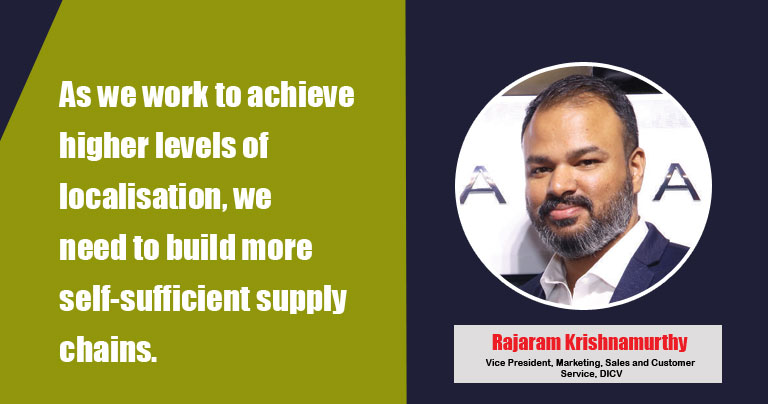We need to boost localisations with self-sufficient supply chain
By Edit Team | November 3, 2021 12:00 pm SHARE

How do you evaluate the recovery in the Heavy Commercial Vehicle market so far?
Medium and heavy truck sales between January and July this year have already surpassed volumes of the entire 2020 and are expected to close at almost double the sales volume, compared to last year. The demand is coming back and recovery from the second wave has been much better than the first one. This year, the market will be a lot better than in 2020 and the industry could come near the peak sales in 2023.
Last year, the industry ended with sales of 106,000 trucks. This year till July, the number was already 107,000 units. If this trend continues, the industry will close at around 205,000. Though demand has still not resumed to normal levels but if it continues like this, then in 2022, the industry would be in the region of 250,000-280,000 trucks which is the 2019 level.
However, diesel price hikes have impacted the recovery. If not for such steep price increases, the market could have grown by another 10-15 percent.
How did you successfully manage your business in the Covid times? What were the key drivers for your business prospects?
DICV was uniquely positioned to weather Covidinduced disruptions due to the strong backing of the global Daimler group, but also due to the approximately 95 percent localisation of its supplier network which allows us to be less reliant on international supply chains. One of the most important lessons was that we need to build more self-reliant supply chains as we continue to work towards achieving higher localisation levels.
We have prioritised our investments mainly in four areas – digitalisation, mobility as a solution and not only as a product, expanding product portfolio, and localisation. DICV believes companies need to embrace change to ensure long-term prosperity. The company has therefore set up the Transformation Management Office (TMO) headed by a dedicated ‘Chief Transformation Officer’. The TMO will prepare DICV for significant disruption in the areas of digitalisation, sustainability, electrification, and company culture.
On the product front, DICV’s new CV portfolio is focused on providing solutions to address challenges posed by Covid thereby enabling our customers to excel in their businesses and benefit society. We are looking to move away from the traditional tonnage classification. Instead, we will focus on creating ‘the best truck for every need’, customising vehicles for use applications, and targeting specific sectors such as e-commerce.
What are the significant factors impacting productivity of efficient and technically upgraded commercial vehicles?
Aligned with the rapidly changing market dynamics and customer needs, BharatBenz’snew range of Commercial Vehicles is characterised by their safety, high performance, fuel efficiency, excellent reliability, and low maintenance cost.
Last year, we positioned our BSVI range based on profit technologyplus with unique attributes on fuel efficiency, maintenance cost, reliability, and safety. With our more than 8 years of global experience in this technology, we are offering up to 10 percent better fuel efficiency in some highly demanding segments like E-commerce as compared to a BSIV.
Furthermore, the maintenance cost of a BharatBenz BSVI vehicle is 6 percent lower than a BSIV. Our Telematics technology, ‘Truckonnect’ introduced with the BSVI portfolio, allows customers to remotely check and analyse vital vehicle information in realtime via an online portal, including vehicle location and health, plus fuel consumption. With this, fleet managers can optimise driver performance, increase fuel efficiency, and reduce downtime. Truckonnect is also well received amongst fleet managers who are seeing a sharp rise in efficiency, which in turn leads to better profits.
How is technology and digitalisation paving ways for development in the commercial vehicle segment?
The automotive sector as a whole has never undergone a greater transformation than what it is adapting to today. Physical restrictions in operations and services have accelerated digitalisation by at least 10 years, but the automotive industry is quickly integrating innovative technologies to ensure resilience.
Another reason digitalisation is coming to the forefront is because customers no longer differentiate their expected levels of technology and convenience by industry. This, along with the need to address the challenges posed by Covid, means the CV industry is moving towards service-based digital offerings. The CV segment, which once solely focused on product, is now demanding digital servitisation. With this in mind, automotive manufacturers such as DICV have doubled their investments in the area of digitalisation.
Can you walk us through your latest additions in this sector? Which new technologies have you added for efficient performance?
DICV has doubled investment in digitalisation projects to advance transformation internally and externally. The additions are directed towards improving efficiency, customer convenience, and filling the gaps due to the disruptions posed by the pandemic. For customers, this is evident with the Proserv App that enables more than 65 kinds of transactions to be completed via an app (service booking, parts ordering, insurance, payment, etc.). Customers can also benefit from the telematics solution Truckonnect/BusConnect which offers them real-time access to data on their entire fleet.
Suppliers, dealers, and key customers also have access to the DICV Bulletin which gives them up-to-date information on the company’s current news topics. Internally, DICV is using large amounts of data to optimise its processes, enhance products, and increase working efficiency. One example of this is the newly launched Virtual Reality Centre (VRC) which allows operators to virtually perform serviceability and accessibility checks using a digital model accessed via 3D goggles and navigational joysticks.
How do you assess the growth prospects for the next 5 years in the commercial vehicle market?
The entire automotive industry, including India, faces cyclical, structural, and transformational storms. However, in the next five years, there will be much progress made on all these three elements. From cyclicality and Indian CV market point of view, we have seen how the market has done in the last few years. From the peak of 2018, the market has drastically come down in two years. I think, in the next five years, this industry will surpass the level we achieved in 2018.
Coming to the structural part, I think there are many changes that are happening in the market. It started with the axle loads; then we have seen huge growth from last-mile delivery or the e-commerce segment, where we have products that are very well accepted by the market. There is massive investment happening in infrastructure and construction, which are our flagship segments.
With expressways, customers will ask for more powerful trucks, leading to the hub and spoke model. It will become a reality in the next five years which will lead to the structure of the industry-changing. And we believe our products are already prepared for that kind of solution. People will look for more efficient fleet utilisation based on connectivity and product performance. The transformational aspect will be sustainability in production, accident-free driving, and MaaS. We are working on these things, and there will be some announcements coming from us in the next few weeks and months.
I am very bullish for the next five years. I believe this will be the most exciting period for the CV industry in India, and I feel very confident that we are pretty well-positioned to make the best out of it and to continue to lead the market in terms of technology and transformation, while at the same time go for healthy and profitable growth.
Cookie Consent
We use cookies to personalize your experience. By continuing to visit this website you agree to our Terms & Conditions, Privacy Policy and Cookie Policy.


































-20240213125207.png)

























